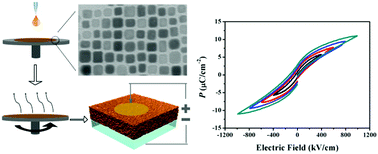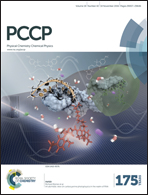Novel lead-free ferroelectric film by ultra-small Ba0.8Sr0.2TiO3 nanocubes assembled for a large electrocaloric effect†
Abstract
A giant electrocaloric effect (ECE) can be achieved in ferroelectric thin films, which demonstrates the applications of thin films in alternative cooling. However, electrocaloric thin films fabricated by conventional techniques, such as the pulsed laser deposition or sol–gel methods, may be limited by high costs, low yield and their dependence on substrates. In this study, we present a new bottom-up strategy to construct electrocaloric Ba0.8Sr0.2TiO3 thin films by assembling precisely designed building blocks of ferroelectric nanocubes, which is supported by detailed structural characterization. Moreover, it is found that our assembled Ba0.8Sr0.2TiO3 films differ remarkably from both individual Ba0.8Sr0.2TiO3 NPs and bulk Ba0.8Sr0.2TiO3 ceramics in terms of new collective ferroelectric properties, including superior and diffused permittivity constants and polarization-electric field loops. Benefiting from these unique ferroelectric properties, a giant ECE (9.1 K) over a broad temperature range (20 °C to 60 °C) is achieved, which is very large in the lead-free oxide film. Clearly, this bottom-up strategy provides a promising pathway for developing high electrocaloric effect devices.


 Please wait while we load your content...
Please wait while we load your content...